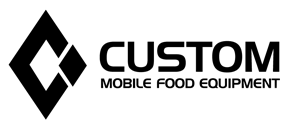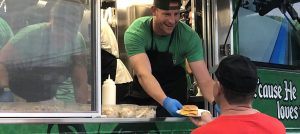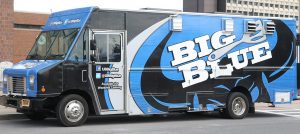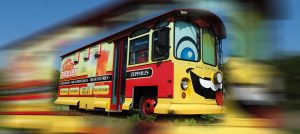In the corner of an otherwise deserted parking lot in Edison, New Jersey, a group of cars is clustered around the blue-and-white Lombardi Pizza Co. truck. Smoke billows from its chimney. At its side people shuffle about, arms crossed or hands in pockets, waiting. Every couple of minutes a pizza box or two appears on the service-window ledge.
Some customers return to their cars to eat. Others carry pizza boxes to the concrete benches near the entrance of the Executive Plaza building, a large, nondescript low-rise whose tenants are mostly medical offices closed for the weekend.
The lot is near where the Garden State Parkway meets the New Jersey Turnpike. This is not a walking community. You would normally drive through it to get somewhere else. But it became a destination when the Lombardi Pizza Co. truck started selling its pies here last summer.

This truck is making pizza that would hold its own in a brick-and-mortar joint. This is not just “good for a truck.” It is great pizza, period. If you live near Edison or have a commute that takes you anywhere near, this is destination pizza, folks.
Owner and pizzaiolo Peter Lombardi (no relation to the Manhattan coal-oven Lombardi’s) does private catering with the truck but parks in this lot on weekends when he doesn’t have an event. (His family owns the property.) Like many food trucks, Lombardi Pizza Co.’s hours and locations are available via social media—in this case its Facebook page, though its website also offers an up-to-date calendar of events.
Lombardi outfitted the truck with a Mugnaini Valoriani wood-burning oven, which is still a rarity among pizza trucks. Most use gas ovens and often parbake pies, finishing them on the vehicle. Lombardi makes the dough at one of his family’s restaurants then loads his truck with it and his other ingredients and makes the pies to order.
It’s a tight space, but the truck has some nice touches, like the prep counter cut to fit the pizza peel. Lombardi works fluidly in the narrow confines, the only time he looks cramped is in using the long peel to move the pizza from the oven to a cardboard tray for packaging.

The undercarriage and hole structure
The crust is crisp, chewy, tender, and airy. Some of my pizzas looked a little too charred, but I didn’t notice an overly bitter or acrid flavor, and most of the charred bits on the rim flaked away as I picked up the pizza.
Lombardi uses a long-rise cold-ferment for the dough, which gives it plenty of flavor. The end crust (or cornicione) is puffy and supple.

The truck offers a regular menu and a separate board with specials. Lombardi often posts photos of the special pies on Facebook as he makes them.

Lombardi’s Bianco pie.
I tried a Bianco (fresh ricotta, parsley, garlic, basil; $11) and a Piccante (tomato sauce, fresh mozzarella, jalapeño, red onion, basil, oregano; $13).

Lombardi’s Piccante pizza.
The Piccante was like a Neapolitan-filtered take on classic American “pizza parlor” pizza—loaded with toppings yet carefully balanced, the can’t miss combination of onions and peppers, in this case spicy peppers. Jalapeños almost always come into play with some sort of meat topping, but in this case soppressata or sausage was unnecessary.

Do I see microblisters? Here’s a close-up of the crust for students of crustology.

Peter Lombardi learned the ropes under Enzo Coccia in Naples in 2009 and then sharpened his skill at Nomad in Hopewell, New Jersey.

This is what happens when a pizza truck uses Square.
Look for his truck in Edison. It’s often open Friday and Saturday for lunch and dinner and Sundays for lunch only. They take cash and cards.
Article by: Serious Seats






